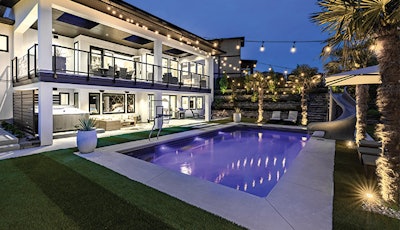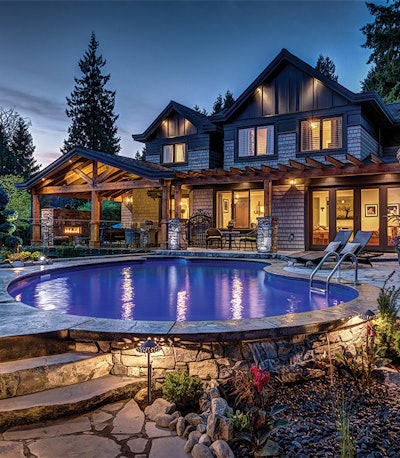
Is a beautiful pool still beautiful in complete darkness? That may be a question best answered by the mystics, but the fact remains that at night, a great pool design demands great lighting to be understood and appreciated.
Or as Jason Brownlee of J.Brownlee Design in Franklin, Tenn., puts it, "You can't rely on light to make a design successful, but you use the light as a way to bring that overall pool experience into the evening. The goal in lighting is to put a crowning touch on the overall space, transition it from day to night and make it come alive when the sun goes down."
That means lighting must be an integral part of the overall design strategy. "Everything that you do surrounding the project does play a role as to how things are going to turn out in the end," adds Rhett Bradshaw, director of operations at Vantage LeisureScapes in Langley City, British Columbia. "Unfortunately, all it takes is for one element to be out of place or be of a lesser quality to detract from the overall project. So, everything plays a role in tying the project together, which is why lighting should not be an afterthought."
RELATED: Wireless: The New Frontier In Pool Lighting
Increasingly, lighting is becoming more important to homeowners, according to Randy Angell of Randy Angell Designs in Plano, Texas. "A lot of my clients bring up lighting in our fi rst consultation," he says. "When they're looking at spending the kind of money that they're spending on these backyards and investing in creating a really good design, they want it lit well."
Pool lighting strategies vary from project to project and often include elaborate use of color-changing dimmable LEDs with warm and cool settings, as well as a combination of uplights and downlights throughout the pool area and surrounding landscape to convert backyards into fl exible and multifunctional afterhours spaces.
But successful lighting requires an eye for detail and a strategic game plan from the start, and it might involve working with a landscape architect or outdoor lighting specialist.
"Think about what you're trying to accomplish, and don't just start randomly sticking lights everywhere," Brownlee warns. "You can screw up lighting pretty easily."
 Light streaming through large windows of a home can add a major component of the overall pool lighting effect. (Photo by Gordon Waddington Photography)
Light streaming through large windows of a home can add a major component of the overall pool lighting effect. (Photo by Gordon Waddington Photography)
THREE BRIGHT IDEAS
The work of Brownlee, Angell and Bradshaw earned them recognition in the 2020 PHTA Awards of Excellence, and what follows are three of their most powerful design tips for pool lighting.
1. START WITH THE POOL
It's easy to get overwhelmed when developing a lighting strategy for a pool project. That's why Angell suggests beginning at the most obvious starting point: the pool itself.
He prefers to use several small lights inside the pool, rather than a few big ones. Lining the length of the pool with color LEDs, for example, creates an even wash of light across the entire vessel and eliminates large, unsightly and even temporarily blinding hotspots. If the pool includes a vanishing edge, consider incorporating uplighting in the lower basin to showcase the exterior wall — especially if it's visible from the home or outdoor gathering areas.
RELATED: Light Patterns: A Pool Project With Creative Lighting
"That's always the starting point with my thoughts on lighting for the pool area — getting the light within the pool right," Angell says. "And then we start thinking about all of the lighting around the pool."
Such lighting could come from existing or planned landscape lighting (more on that later), as well as the interior and exterior of the home. Ambient lighting from a well-lit home with large windows can reduce the degree of overall backyard lighting required, for example, leaving you free to focus on showcasing individual elements.
 In large-scale work, grand reflections, such as these Romanesque arches, paint a picture in light on the pool surface. (Photo courtesy J. Brownlee Design)
In large-scale work, grand reflections, such as these Romanesque arches, paint a picture in light on the pool surface. (Photo courtesy J. Brownlee Design)
2. FIND A FOCAL POINT
While the pool is a critical component of an overall lighting strategy, don't overlook the dramatic impact of, say, an ornamental tree that could serve as an illuminated centerpiece around which several additional lighting features evolve.
"It's not really about what the specific item is; it's more about where I want my eye to go when I'm in the space," Brownlee says. "Then you design lighting around that, so it becomes the focal point. Other areas of the space can become important elements, using a light-dark, light-dark pattern that really gives you a space that feels comfortable and interesting."
Brownlee recommends against illuminating most or all trees or wall surfaces, because too much brightness can spoil the overall effect, mood and beauty of a given space. Instead, find ways to incorporate components, such as fire features, into the space. Linear fire pits and fire bowls can enhance the dynamics by blending electrical and natural elements.
"Fire is one of those lighting components that has such an earthy, warm feel to it," Angell says. "Most people want to incorporate fire somewhere into the design, because it has a combined visual and social impact. It's something they can gather around."
Just don't go crazy with the fire, he warns, noting that he's had to dial back the ambitions of some clients because they envisioned a "Vegas kind of vibe," which works better on the Las Vegas Strip than in a backyard.
3. LEVERAGE THE LANDSCAPING
Consider the location and aesthetics of surrounding plants and other foliage, as well as hardscape areas and the overall lay of the land, when developing your lighting strategy — always keeping in mind proximity to and connection with the home. Downlights in trees can add touches of mystery and elegance, and deck soffits and subtle ground lights work well to create cozy atmospheres while still illuminating the pool area for safety purposes.
That said, landscape lighting can require extensive planning and complex wiring, which is why some homeowners opt to hire separate pool designers and landscape architects. "In that case, it's easy for everybody to have a different idea of what's important, but making sure those ideas work together is so key," Bradshaw says, adding that communication throughout the project is critical.
If you have a say in the matter — meaning the homeowner hasn't chosen a landscape architect independent of your input — suggest a reputable company, encourage the homeowner to seek and check references, and make sure both your crew and the landscape architect's team are comfortable with the agreed-upon plan.
 Submerged pool lights illuminate this tile wall creating a spectacular effect. (Photo courtesy Pool Environments)
Submerged pool lights illuminate this tile wall creating a spectacular effect. (Photo courtesy Pool Environments)
ILLUMINATING ADVICE
Generally speaking, according to Brownlee, more light is better than less. Be aware, however, that it is possible to draw too much attention — or not enough — to an object and disrupt the overall lighting balance. "That can defeat the entire space at night," he says. "Know what you're trying to do. What do you want to be dominant, and what do you want to feel like part of the overall design? Then use lights to create that feeling."
RELATED: Lessons in Light
For some pool builders, that's easier said than done. Fortunately, educational opportunities are available from Genesis and other organizations and online resources to help builders expand their pool lighting knowledge.
Angell also suggests partnering with an outdoor lighting company (budget permitting) to help take a project to the next level. "The photos of mine that garner the most attention are usually the nighttime shots that are incredibly well lit," he says. "And most of those are done by Landmark Design Co. [in Richardson, Texas], which I work with on a lot of my projects. Connection with a good lighting company does pay off, and we drive and push each other to expand our horizons and be as creative as we can."
The majority of Angell's projects carry a price tag of $200,000 to $250,000, and he says it's not unusual for $20,000 to be designated specifically for lighting.
"It can be a struggle for builders, because they are working against budgets, and lighting is one of those things that is kind of easy for the builder to shy away from, because it's money coming out of the budget. Plus, in the daytime, those lights mean nothing," he says. "But if you're trying to up your game and want to set yourself apart as a builder, lighting is one of the ways in which you can do that."
Bradshaw notes the ample lighting — the right amount in the right places — has become an easier sell in recent years, thanks to advancements that allow homeowners to control it all from their smart devices.
"There are a number of options available now for lighting automation, much more than there used to be and mainly because it's something people expect now," he says. "You can sit in your living room and turn on the pool lights, or light up the backyard on your way home from work."
Remote lighting control excites customers in ways that other automation features don't, he adds. "You can be sitting in your backyard with friends, pull out your phone and say, 'Hey, watch this!' And all of a sudden the pool lights change color right in front of you," Bradshaw says. "That's a lot more fun than saying, 'Guess what? I just turned up the speed of my pump.' It might not necessarily be a priority, but it's something people get excited about and helps them have fun with their lighting system."
This article first appeared in the June 2021 issue of AQUA Magazine — the top resource for retailers, builders and service pros in the pool and spa industry. Subscriptions to the print magazine are free to all industry professionals. Click here to subscribe.












































